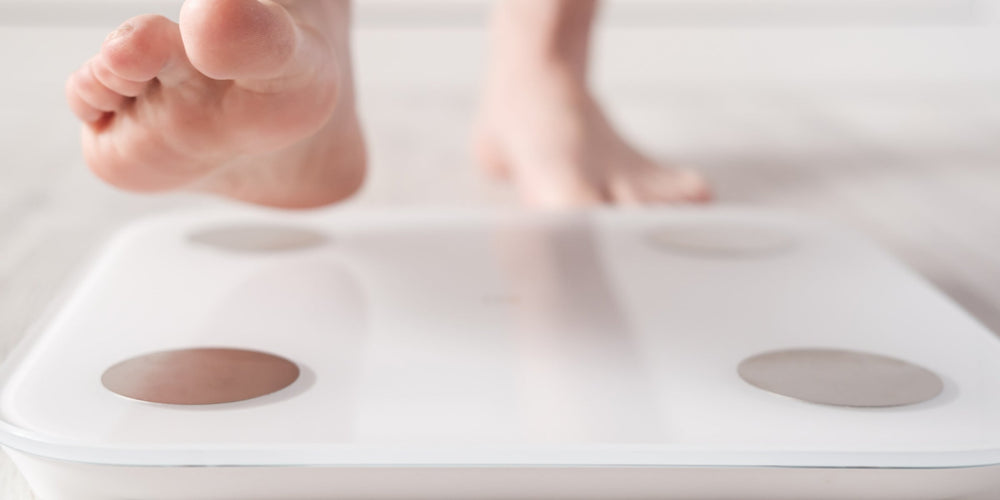How Accurate Are Body Fat Scales? Pros and Cons to Consider

Stay tuned to our latest news
Article revisions made on April 22, 2025
If you're on a health and fitness journey, you've likely come across body fat scales as a tool to track your progress. These body composition scales promise to provide an accurate measurement of your body composition, allowing you to monitor changes in your body fat percentage over time.
But how reliable are they, really? While they can be a convenient way to get an estimate of your body fat levels, there are several factors to consider when interpreting the readings. With that said, let’s dive into the pros and cons of using a body fat scale, so you can decide if it's a worthwhile investment for your health and fitness goals.
What Are Body Fat Scales?

Body fat scales are advanced weighing scales that not only measure your body weight but also provide insights into your body composition, such as bone mass, muscle mass, and even water weight. These scales use a technology called bioelectrical impedance analysis (BIA) that sends a safe low-level electrical current through your body to measure the amount of fat versus lean body mass. By analyzing the resistance of the electrical current, body fat scales can calculate your body fat percentage, muscle mass, water percentage, and even bone density. This information is essential for understanding your overall health and tracking your progress in fitness and weight loss journeys.
Body fat scales have become increasingly popular as they offer a more comprehensive and accurate reading of a person's body composition in comparison to standard scales. They provide valuable information for individuals striving to achieve specific fitness goals or monitor their overall health, making them an invaluable tool for anyone interested in improving their well-being.
How Do Body Fat Scales Work?
As mentioned before, these scales utilize a technique called bioelectrical impedance analysis (BIA) to estimate body composition metrics. They send a low-level electrical current through the body, which measures the resistance encountered to calculate the body fat percentage.
When the scale is stepped on, the electrical current flows through the body. This current mainly travels through water, electrolytes, and other conductive tissues found in our bodies. Since muscle tissue contains more water and electrolytes, it tends to conduct the electrical current more easily than fat tissue, which contains less water.
The scale measures the resistance encountered by the electrical current as it passes through the body. By analyzing this resistance, the scales can estimate the body fat percentage. Since fat tissue is not as conductive as muscle tissue, it presents a higher resistance to the electrical current.
Using the known differences in electrical conductivities between muscle and fat, the scale can calculate an estimated value for body fat percentage. It considers factors such as the person's height, weight, age, and gender to provide a more accurate estimation.
Are Body Fat Scales Accurate?
Smart scales and body fat scales have been the subject of several studies aimed at determining their accuracy in measuring body composition. The findings from these studies suggest that while these scales can provide a general estimate of body fat percentage, they may not be as accurate as more advanced methods such as DEXA scans.
One study compared the accuracy of smart scales and DEXA scans in measuring body composition and found that the smart scales tended to overestimate body fat percentage, particularly in individuals with higher body mass index (BMI). On the other hand, DEXA scans were found to be more accurate and reliable in measuring body fat percentage.
The accuracy of body fat scales can also be affected by various factors, such as hydration levels and body posture. Some studies have shown that fluctuations in hydration levels can significantly affect the readings provided by these scales, leading to inaccurate results. Additionally, body posture can impact the accuracy of the measurements, with certain positions leading to skewed readings.
Furthermore, it is important to note that body fat scales provide only an estimate of body fat percentage and may not consider other factors such as muscle mass and distribution. This limitation can further affect the accuracy of these scales.
What Could Potentially Cause Body Fat Scales to Be Inaccurate?
Smart scales, like any other measuring device, can be prone to certain inaccuracies. Several potential factors can contribute to the inaccuracy of smart scales.
One of the primary factors is surface contact. Smart scales rely on electrodes located on the scale's surface to measure body composition. If there is poor contact between the feet and the electrodes, the measurements can be affected. Irregularities in the floor surface, such as rugs or uneven tiles, can interrupt the electrical flow and lead to inaccuracies.
Foot position is another crucial aspect that can impact measurement accuracy. It is important to stand correctly on the scale, with the feet aligned evenly and centered on the designated areas. If the feet are not correctly positioned or if only one foot is placed on the scale, the measurements may not be accurate.
Leg flexion, or bending the knees, can also affect the results obtained from smart scales. The recommended position for measuring body composition is to stand with straight legs. Bending the knees can alter the weight distribution and affect the measurement of body fat and muscle mass.
For calculating whole body fat-free mass (FFM) and fat mass (FM), regression equations are commonly used. These equations are based on various parameters such as height, weight, age, and gender. The specific regression equation used can vary depending on the brand and model of the smart scale.
To obtain an accurate reading from smart scales, it is crucial to follow the instructions provided by the manufacturer. Maintaining consistent positioning on the scale, ensuring proper surface contact, and standing with straight legs are essential instructions to be followed. Consistency in following these instructions will lead to more accurate and reliable measurements of body composition using smart scales.
What Do People Need to Consider Before Getting Body Fat Scales?

Before you rush out to purchase a body fat scale, there are several important factors you'll want to take into account. One of the primary considerations is the accuracy of body fat scales. While they can provide a rough estimate, these devices often have a margin of error of 3-5% compared to more sophisticated methods like DEXA scans or hydrostatic weighing. Factors like hydration levels, body type, and even the positioning of the feet on the scale can impact the readings.
You'll also want to consider the cost and quality of the device. Body fat scales can range greatly in price, from under $50 to over $100 for higher-end models. Keep in mind that you generally get what you pay for – cheaper scales tend to be less accurate and durable than their more expensive counterparts. It's important to understand that body fat percentages can vary significantly from person to person, even among those of similar height, weight, and body type. Factors like age, gender, and muscle mass can all influence your "normal" body fat range.
Finally, it's crucial to recognize the limitations of home testing. While body fat scales can provide a starting point, they shouldn't be treated as a replacement for professional body composition assessments. For the most accurate and comprehensive understanding of your health markers, consulting a qualified healthcare or fitness professional is advised. By carefully considering these factors, you can make a more informed decision about whether investing in a body fat scale aligns with your health and fitness goals.
3 Pros of Body Fat Scales
One of the main advantages of body fat scales is their convenience and accessibility. These devices allow you to easily monitor your body composition from the comfort of your own home, without having to schedule an appointment with a healthcare or fitness professional. This makes it easier to track changes over time and adjust your diet and exercise routine accordingly.
Stepping on a body fat scale on a regular basis can also help increase your accountability and motivation on your health and fitness journey. Seeing the numbers change (or not change) can provide valuable feedback and inspire you to stay consistent with your wellness practices.
While body fat scales may not be as accurate as more advanced testing methods, they can still provide a general baseline measurement of your body composition. This data point can be useful in conjunction with other health markers, such as weight, BMI, and circumference measurements, to get a more comprehensive picture of your overall health status.
3 Cons of Body Fat Scales
One of the major drawbacks of body fat scales is their limited accuracy. These devices use bioelectrical impedance analysis (BIA) to estimate body composition, which can be influenced by factors like hydration levels, muscle mass, and even the position of your feet on the scale. This can lead to significant variations in the readings, reducing the reliability of the data.
While body fat scales provide a general estimate of your body fat percentage, they do not offer a complete picture of your overall health and fitness. Important factors like bone density, muscle mass, and visceral fat levels are not accounted for in these measurements. For a more comprehensive understanding of your body composition, it's best to consult with a healthcare or fitness professional.
The body fat percentage readings from these scales can also be easy to misinterpret, especially for individuals who are new to tracking their body composition. Sudden changes in the number may not necessarily reflect actual changes in body fat, leading to confusion and potential frustration.
Are There Alternative Methods of Measuring Body Fat?

There are several alternative methods available for measuring body fat besides the traditional methods like BMI. These alternative methods include waist circumference, Dual X-Ray Absorptiometry (DXA), Bod Pod, Bioelectrical Impedance Analysis (BIA) devices, hydrostatic weighing, and skinfold measurements.
Waist circumference is a simple and non-invasive method to estimate body fat. It involves measuring the circumference of the waist using a measuring tape. Higher waist circumference is associated with higher levels of abdominal fat and increased health risks.
DXA is a highly accurate method that uses X-rays to measure the amount of lean tissue, fat, and bone in the body. It provides a detailed assessment of body composition and is commonly used in research and clinical settings.
Bod Pod is another alternative method that uses air displacement to measure body composition. It works by calculating body density based on the volume of air displaced by the individual inside the chamber. This method is quick and non-invasive, making it suitable for a wide range of individuals.
BIA devices use electrical impulses to estimate body composition. These devices send a low-level electrical current through the body and measure the resistance to the flow of the current. Since fat has a higher resistance compared to lean tissue, BIA devices can estimate body fat percentage.
Hydrostatic weighing involves measuring the displacement of water when a person is submerged in a tank. This method relies on the principle that lean tissue is denser than water, while fat tissue is less dense.
Skinfold measurements involve using calipers to measure the thickness of subcutaneous fat at specific sites on the body. These measurements are then used to estimate overall body fat percentage.
Takeaway
Body fat scales can be a useful tool for tracking your health and fitness journey, offering a convenient way to estimate body composition from home. They use bioelectrical impedance analysis (BIA) to provide readings on body fat percentage, muscle mass, water percentage, and bone density. However, their accuracy can be influenced by factors such as hydration levels, body posture, and the quality of the scale itself.
While these scales can offer a general baseline measurement and motivate users by providing regular feedback, they also have limitations. They may not be as precise as more advanced methods like DEXA scans or hydrostatic weighing and can be affected by variables that lead to inconsistent readings. Additionally, they do not account for all health markers, such as bone density and visceral fat levels, which are important for a comprehensive understanding of one’s health.
Before investing in a body fat scale, consider the potential margin of error, the cost, and the importance of supplementing these measurements with professional assessments. By weighing these factors, you can make a more informed decision about whether a body fat scale is a worthwhile investment for your health and fitness goals.
RENPHO Health Tips
-

Creating the Best You: Setting Realistic Expectations When Losing Weight
July 7, 2024
Read more >
-

Hold Back on the Bite: Finding Balance in Mindful Eating
June 24, 2024
Read more >
-

Prioritizing Pregnancy Safety: Is a Smart Scale the Wise Choice?
June 20, 2024
Read more >
-

Shrinking Dishes: Exploring the Reasons Why Food Portions Decrease During Cooking
June 13, 2024
Read more >
-

Pregnant and Achy? Discover How a Leg Massager Can Provide Relief and Improved Circulation
June 3, 2024
Read more >





